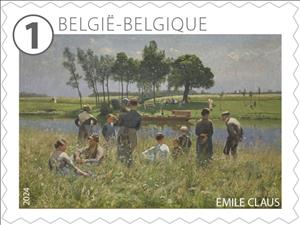Stamp: The Art of Emile Claus (Belgium 2024)
The Art of Emile Claus (Belgium 2024)
10 June (Belgium ) within release The Art of Emile Claus (2024) goes into circulation Stamp The Art of Emile Claus face value 1 No Face Value
| Stamp The Art of Emile Claus in catalogues | |
|---|---|
| Colnect codes: | Col: BE 2024.06.10-03i |
Stamp is horizontal format.
Stamp from booklet. Face value € 1.43 on day of issueAlso in the issue The Art of Emile Claus (2024):
- Booklet - The Art of Emile Claus face value 10*1;
- Stamp - The Art of Emile Claus face value 1;
- Stamp - The Art of Emile Claus face value 1;
- Stamp - The Art of Emile Claus face value 1;
- Stamp - The Art of Emile Claus face value 1;
- Stamp - The Art of Emile Claus face value 1;
- Stamp - The Art of Emile Claus face value 1;
- Stamp - The Art of Emile Claus face value 1;
- Stamp - The Art of Emile Claus face value 1;
- Stamp - The Art of Emile Claus face value 1;
- Stamp - The Art of Emile Claus face value 1;
Stamp The Art of Emile Claus it reflects the thematic directions:
Art is a diverse range of human activities in creating visual, auditory or performing artifacts (artworks), expressing the author's imaginative or technical skill, intended to be appreciated for their beauty or emotional power. In their most general form these activities include the production of works of art, the criticism of art, the study of the history of art, and the aesthetic dissemination of art. The oldest documented forms of art are visual arts, which include creation of images or objects in fields including painting, sculpture, printmaking, photography, and other visual media. Architecture is often included as one of the visual arts; however, like the decorative arts, or advertising, it involves the creation of objects where the practical considerations of use are essential—in a way that they usually are not in a painting, for example. Music, theatre, film, dance, and other performing arts, as well as literature and other media such as interactive media, are included in a broader definition of art or the arts. Until the 17th century, art referred to any skill or mastery and was not differentiated from crafts or sciences. In modern usage after the 17th century, where aesthetic considerations are paramount, the fine arts are separated and distinguished from acquired skills in general, such as the decorative or applied arts.
Family (from Latin: familia) is a group of people related either by consanguinity (by recognized birth) or affinity (by marriage or other relationship). It forms the basis for social order. The purpose of the family is to maintain the well-being of its members and of society.[according to whom?] Ideally, families offer predictability, structure, and safety as members mature and learn to participate in the community. Historically, most human societies use family as the primary purpose of attachment, nurturance, and socialization
A landscape is the visible features of an area of land, its landforms and how they integrate with natural or man-made features. A landscape includes the physical elements of geophysically defined landforms such as (ice-capped) mountains, hills, water bodies such as rivers, lakes, ponds and the sea, living elements of land cover including indigenous vegetation, human elements including different forms of land use, buildings and structures, and transitory elements such as lighting and weather conditions. Combining both their physical origins and the cultural overlay of human presence, often created over millennia, landscapes reflect a living synthesis of people and place that is vital to local and national identity. The character of a landscape helps define the self-image of the people who inhabit it and a sense of place that differentiates one region from other regions. It is the dynamic backdrop to people’s lives. Landscape can be as varied as farmland, a landscape park, or wilderness. The earth has a vast range of landscapes, including the icy landscapes of polar regions, mountainous landscapes, vast arid desert landscapes, islands and coastal landscapes, densely forested or wooded landscapes including past boreal forests and tropical rainforests, and agricultural landscapes of temperate and tropical regions.



